10 Major Ports of Uruguay
Uruguay is situated in South America and is classified as a developing country by international organisations. Effective implementation of government policies has earned Uruguay a prestigious position in the continent in terms of human development rankings, economic growth and overall socio-economic development.
Agriculture is the mainstay of the economy comprising 65 per cent of its exports. Other crucial sectors include banking and tourism. More than 80 per cent of its population dwells in urban areas and the biggest industrial region is located in the capital city of Montevideo.
In terms of port infrastructure, the country ranked second in the entire continent as per the 2016-17 Global Competitiveness Report of the World Economic Forum. It has 3 cargo ports and multiple marinas and coastal towns lying on its Atlantic coast.
Uruguay exports meat, dairy products, grains, chemicals, rice, and forestry products and imports crude oil, petroleum products, packaged medicaments, automobiles, pesticides and broadcasting equipment. It has trade relations with China, the US, Japan, Germany etc. Let us review the 10 major ports of Uruguay and their features.
1. Port of Montevideo
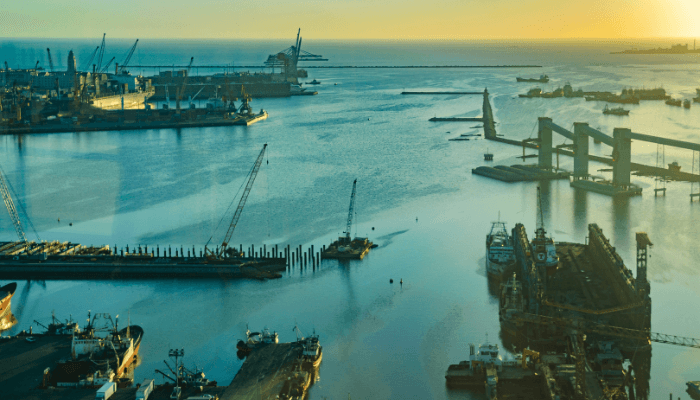
Lying on the banks of the Rio de La Plata River, Montevideo is the main port of Uruguay, equipped with high-tech facilities for dealing with general cargo, containers, RORO, breakbulk, liquid bulk, reefer cargo such as seafood and LPG.
A sheltered port within the Bay of Montevideo, it is one of the busiest ports on the eastern South American coast and contributes significantly to the nation’s economy. It functions as a vital maritime gateway for landlocked countries of Bolivia, Paraguay, parts of Brazil and Argentina.
It is a free port and a major transhipment centre that supports many local industries. It has processing plants involved in packaging meat, wool and agro-based products. Approximately 4800 cargo ships carrying 7,600,000 tonnes of cargo and 589,000 TEUs are handled at the port annually.
Port Specifications
Montevideo’s access channel has two sections and is protected by the west and the east breakwaters. It also has a 200-hectare anchorage area, three basins and a government-owned oil facility situated on the northern side of the bay.
Known as the La Teja Refinery, it became operational in 1937 and produces 50,000 barrels of oil each day. It is connected to the oil terminal of the Montevideo port and is the only petroleum refinery in the country that produces light-grade oil goods utilised by the regional industries.
Port Quays and terminal facilities
Puerto de Montevideo contains 13 wharves covering 3,800 m with water depths ranging from 5 to 10 m. Muelle de Escala handles containers while Muelle Fluvial is close to the container terminal and is reserved for exclusive use by the country’s navy.
There are two terminals owned by private companies namely, the Granelera Montevideo terminal which specialises in bulk cargo and the Cuenca del Plata terminal which handles containers.
Muelle Maciel wharf is 382 metres long and serves the Passenger terminal with regular ferries to Buenos Aires, Argentina. The Cabecera Muelle A incorporates two berths with inbuilt ramps for accommodating RORO carriers. Muelle Central covers 392 metres and deals with solid bulk and containerized cargoes. It is equipped with cold storage facilities for storing frozen food and fruits. The 600 m Muelle Mantras wharf accommodates national fishing vessels and has a cold storage warehouse covering 15,000 m2.
For improving infrastructure, boosting capacity and developing Montevideo as a crucial logistics hub, the government has undertaken an expansion project. With an initial investment of 280 million dollars, the port authority is supervising the construction of a pulp terminal with a total handling capacity of two million tonnes of pulp. It will be linked to the Paso de Los Toros pulp mill in the western port area and is set to open in 2023.
2. Port of Sauce de Juan Lacaze
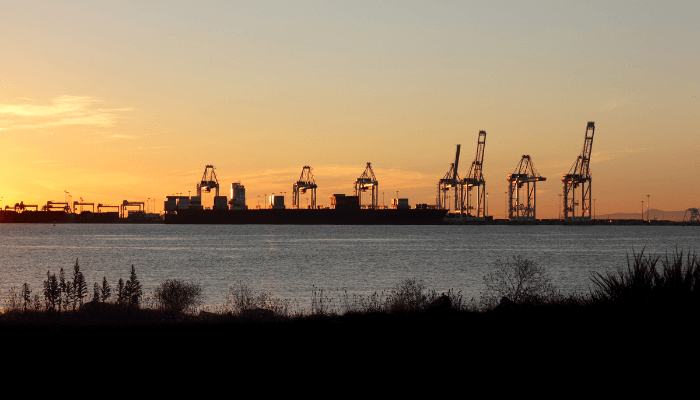
Juan Lacaze or Port Sauce is situated on the shores of the Rio de la Plata River, just 35 kilometres from Colonia. It is connected to the cities and the hinterland via National Route 54. The port handles general cargo, and breakbulk and also undertakes the transhipment of oil. It has business relations with Argentina, Paraguay and Brazil served by regular ferry lines.
The port has a 98 m long pier with a water depth of 5 m, adjacent to the agricultural and industrial area. The National Paper Factory located in the port premises supplies paper to the national as well as the international markets. It also has a stern ramp for loading and unloading automobiles. The Nautical Club in the port offers sports facilities and organises sailing competitions twice a year.
The port was refurbished in 2018 with the construction of an additional 150 m dock for accommodating RORO vessels. Two warehouses covering 2500 m2 were also built along with an open storage area.
3. Port of Nueva Palmira
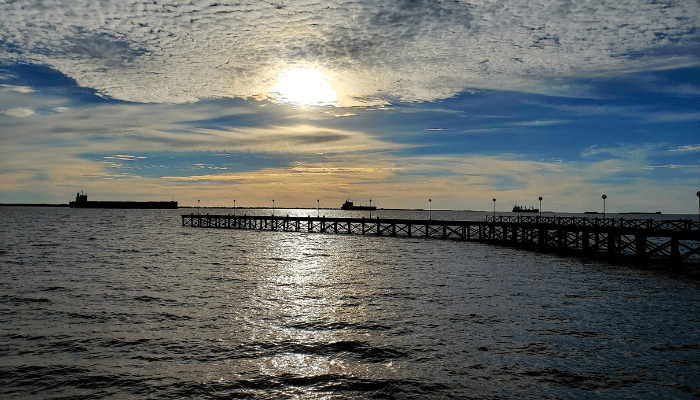
The Nueva Palmira port lies on the eastern bank of River Uruguay and is only 300 kilometres from Montevideo. It has 2 L shaped docks handling cereals, barley, cellulose, fertilisers, citrus fruits, iron ore, manganese, wood etc. Enjoying a strategic position on the Parana- Paraguay waterway, it is one of the busiest ports of Uruguay. It is a key maritime gateway, linked with the inland waterways of South America and also the oceanic corridors traversing the Atlantic and Pacific coasts.
Administered by the National Ports Administration, Neuvo Palmira consists of a Corporacion Navios SA terminal located downstream and the Ontur SA terminal lying north of the main port area.
Port terminals
Supervised by the Terminales Graneleras Uruguayas consortium, the ANP terminal has silos for storing agricultural products with a capacity of 92,000 tonnes. It also has a grain loader and a conveyor belt system linked to the three-grain berths.
The Ultramar wharf is 370 metres long and is divided into two positions called Ultramar Sur and Norte pier. The former handles liquid fertilisers and is connected to the fertiliser plant with a capacity of 11,000 m3 while the latter is linked to the Grupo Maccio processing plant. Norte pier has modern equipment for loading solid bulk cargo.
The port also has a 196 m dock for accommodating three river barges at once, plying on the Uruguay-Paraguay waterway, shipping perishable items and consumer goods.
4. Port of Fray Bentos
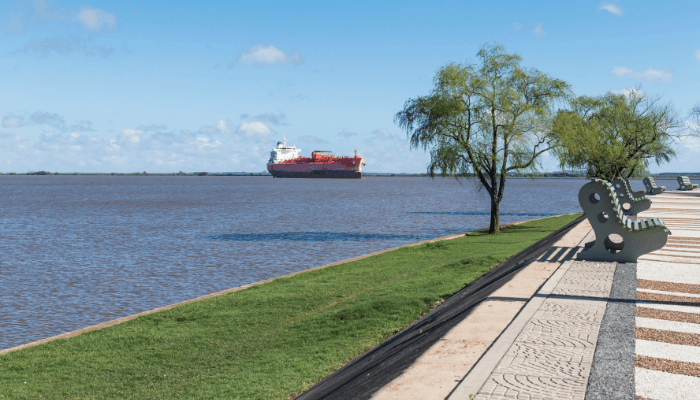
Fray Bentos port lies on the southern bank of the Uruguay river around 320 kilometres from Montevideo. It consists of two L shaped and one T shaped wharf, a meat processing plant and a grain terminal. The port’s strategic location along with great road connectivity enables it to handle greater volumes of cargo comprising forest products, citrus fruits, barley, fertilisers and sunflower oil.
The main storage terminal covering 10 hectares is connected with the national railway for the convenient loading and distribution of timber and logs.
Close to the Puerto Unzué international bridge, Fray Bentos offers the shortest transportation route between the city of Montevideo and the Argentine capital Buenos Aires. It is also connected to the industrial zone of Argentina, Chile and the Rio Grande do Sul in Brazil.
5. Port of Colonia
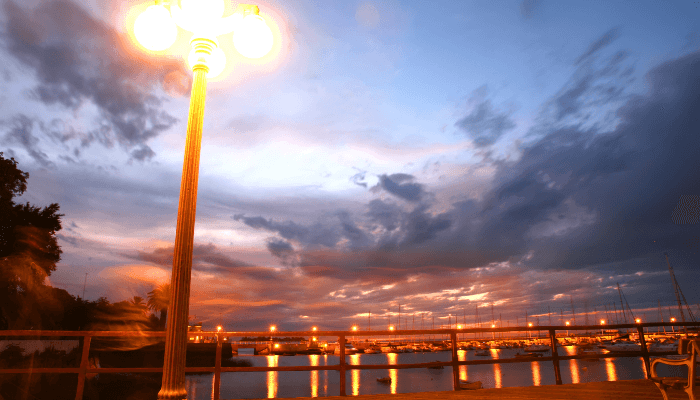
Colonia port lies on the northern banks of the River Plate. It contains an angled breakwater, a turning basin and three U-shaped cement wharves. A major port, it handles mainly automobile transshipments and passengers on its ferry terminal. The port has two electric cranes for lifting five tonnes and two ramps for trucks and cars.
The port houses the Zona Franca de Colonia or the Free trade zone. The historical city founded by the Portuguese in 1680 contains the famous Colonia del Sacramento, an 18th-century bastion that was declared a UNESCO World Heritage site in 1985.
People visit the coastal city for its colonial architecture, the Church of the Sacrament, San Miguel and San Teresa forts. Most famous is the archaeological museum housed in a 17th century stone building built by the Spanish. Colonia is also known for its beaches, resorts, and old streets like the Cale de Los Suspiros or the Street of the Sighs which leads to the seafront.
The economy of Colonia rests on tourism and the city is also an important manufacturing and packaging centre serving the nearby agricultural region that produces grains, fruits and vegetables.
6. Port of Paysandu
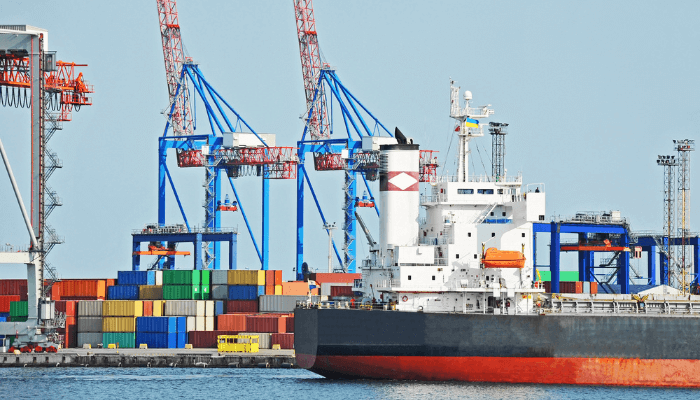
Paysandu commercial port has a privileged position on the Uruguay River Waterway, which enables the shipping of cargo through the Paraguay – Paraná Waterway and the Bioceanic Transportation Corridor. It has extensive facilities for handling bulk cargo such as sugar, barley, soybean, malt etc. Paysandu is connected to the Nueva Palmira and Fray Bentos ports through inland waterways.
The port has a 100 m long reinforced concrete dock equipped with a gantry crane and a cabotage dock covering 300 metres. Indre SA operates two suction dredgers used for extracting sand and stone from the river bed, an important raw material for the construction industry.
7. Port of La Paloma
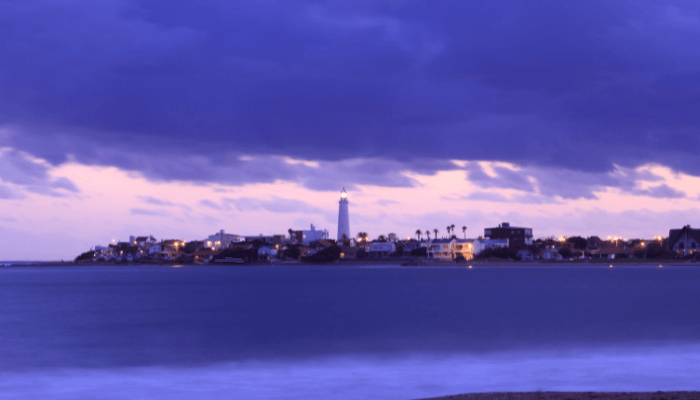
La Paloma is the easternmost port of the country, just a kilometre from the main commercial centre. Opened in 1910, it does not handle much cargo but provides an expansive anchorage area for fishing vessels and small boats. It has a 300 m long wooden pier with a 7.5 m water depth for accommodating yachts and a repair workshop. The premises contain an old seafood processing plant that is currently not operational.
A new dock was built in 2015 for mooring artisanal fishing vessels. Lined along the wharf are numerous stalls selling fresh fish, fritters and fish cakes.
8. Port of Jose Ignacio
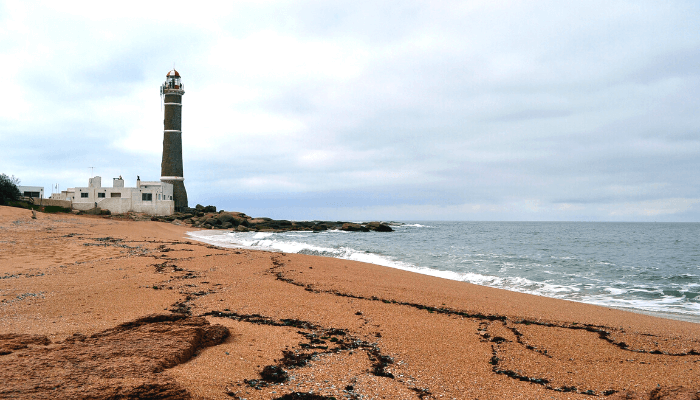
Jose Ignacio lies in the Atlantic ocean, a few miles northwest of Punta Del Este. It has a Single Point Mooring Buoy called the del Este terminal, owned and operated by the national oil corporation, ANCAP. It is positioned 2 nautical miles offshore and can accommodate 150,000 DWT oil tankers with an average discharge rate of 7000 cbm per hour. The terminal can store up to 530,000 m3 of crude oil and is connected to the Montevideo oil refinery through a submarine pipeline.
9. Punta del Este Port
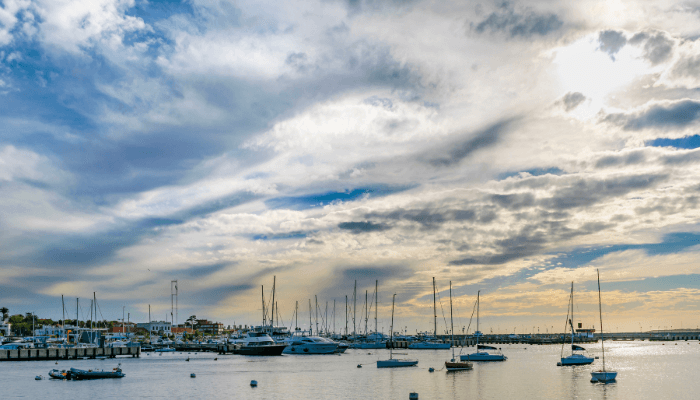
The port of Punta del Este lies on Maldonado Bay and is a famous resort city in the southeastern part of the country. The pleasure port is protected by a 450 m long breakwater on its western side and accommodates yachts and small crafts. It has numerous white-sand beaches including the La Barra known for water sports and scuba diving. The Lighthouse and Candelaria church is just a 10-minute walk from the Punta del Este port. Spotted sea lions can be seen relaxing on the rocky shore and regular ferries operate to the Lobos and Gorriti islands.
10. Port of Piriápolis
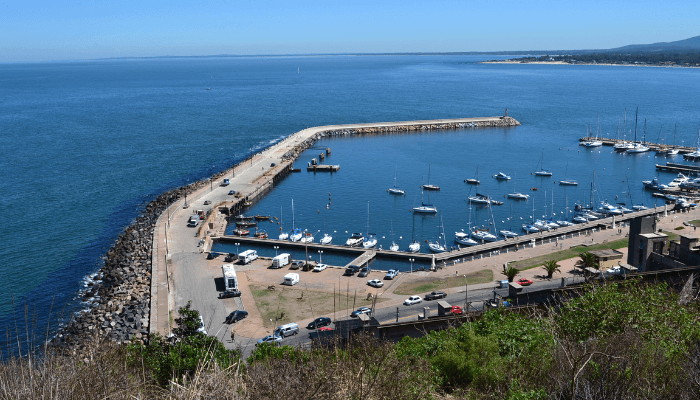
One of the oldest coastal cities of Uruguay, Piriapolis has a beautiful waterfront and an economy centred on tourism and small-scale manufacturing. It has small resorts with beach-side huts, affordable eateries and local cafes. Unlike many other towns, Piriapolis is known for its vibrant nightlife and casinos. The Templo San Antonio located on a hill offers a panoramic view of the coast. Cerro Pan de Azucar is one of the highest mountains in the country and a biosphere reserve too. Piria castle is another attraction along with the local market selling handmade stuff.
Piriapolis port accommodates small passenger ships and provides facilities for boating and fishing.
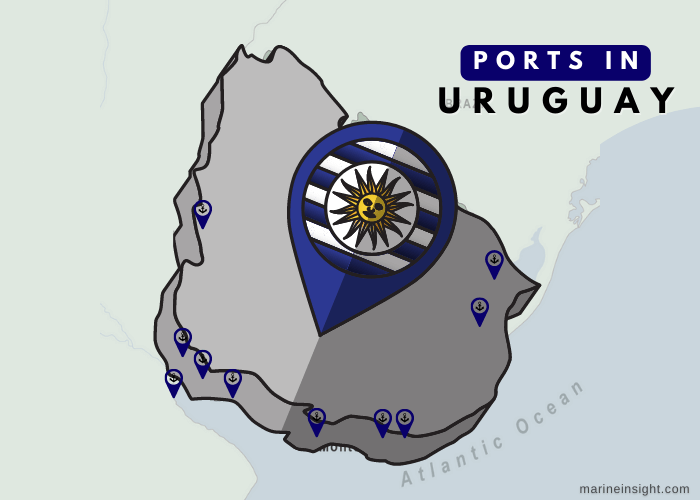
Disclaimer :
The information contained in this website is for general information purposes only. While we endeavour to keep the information up to date and correct, we make no representations or warranties of any kind, express or implied, about the completeness, accuracy, reliability, suitability or availability with respect to the website or the information, products, services, or related graphics contained on the website for any purpose. Any reliance you place on such information is therefore strictly at your own risk.
In no event will we be liable for any loss or damage including without limitation, indirect or consequential loss or damage, or any loss or damage whatsoever arising from loss of data or profits arising out of, or in connection with, the use of this website.
Do you have info to share with us ? Suggest a correction
Disclaimer :
The information contained in this website is for general information purposes only. While we endeavour to keep the information up to date and correct, we make no representations or warranties of any kind, express or implied, about the completeness, accuracy, reliability, suitability or availability with respect to the website or the information, products, services, or related graphics contained on the website for any purpose. Any reliance you place on such information is therefore strictly at your own risk.
In no event will we be liable for any loss or damage including without limitation, indirect or consequential loss or damage, or any loss or damage whatsoever arising from loss of data or profits arising out of, or in connection with, the use of this website.
Latest Maritime Knowledge Articles You Would Like:
Subscribe To Our Newsletters
By subscribing, you agree to our Privacy Policy and may receive occasional deal communications; you can unsubscribe anytime.















